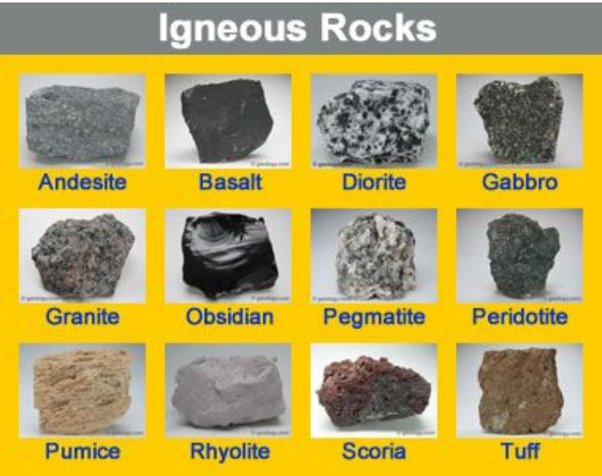What is Igneous Rock?
Igneous rock ( also called magmatic rock) is one of the 3 main types of rocks and it is formed by the cooling and solidification of magma.
Igneous rocks are characterized by a deposit of different minerals, and they’re glassy or coarse in nature. Igneous rocks are also some of the hardest rocks and they do not react with acids.
Types of Igneous Rocks
There are basically two types of igneous rocks – Intrusive and Extrusive rocks, or Plutonic and Volcanic Rocks.
Igneous rocks can also be classified based on their characteristics, that is, Felsic, Intermediate, Mafic or Ultramafic rocks.
How igneous Rocks are Formed
Igneous rocks are formed by the outburst and subsequent solidification of molten material referred to as magma under high temperatures, pressure to the atmosphere.
The magma consists of molten rock material in suspended solid and dissolves gases that are volatile in nature.
Factors affecting the formation of Igneous Rocks
During the process of igneous rock formation, certain conditions control the time and kind of igneous that are formed.
- The cooling rate of the magma
- chemical composition of the magma
- Water composition
- Depth solidification of magma
The cooling rate of the Magma
The rate of cooling determines the texture of igneous rock. If the cooling is slow, as in the case of magma within the earth’s crust, the igneous rock formed will be coarse in texture.
This is because, under this condition of slow crystallization, the mineral particle has an opportunity to grow to a considerable size, and this type of igneous rock is referred to as plutonic or intrusive.
However, when there is a sudden cool especially when it is extruded into the earth’s surface by volcanic nation and they are normally fine-grained and are known as volcanic or extrusive igneous rock.
Chemical composition
Any type of igneous rock formed has much silica. Magma rich in silica is very viscous, slowing down the rate at which crystals can grow thereby leading to find a texture or the acidity of these rocks.
Water content
As the water in manga increases so does the size of the crystal that grows during solidification.
Depth of solidification
The depth at which magma solidifies indirectly influences how the magma solidifies.
At great depth, the magma cools more slowly but near the earth’s surface, it’s lesser, and when between the earth’s surface, it cools more rapidly.
Examples of Igneous Rocks
Examples of Intrusive igneous rock or plutonic rock are Granite, Gabbra, Diorite, Pegmatite, etc
Some popular examples of Extrusive igneous rocks are Basalt, Scoria, Obsidian, Andesite, Pumice, and Rhyolite.
- Granite
It is the ore common type of igneous rock and it has been exposed to the atmosphere of the heart through the action of erosion.
The texture is usually a coarse grey light color and consists mainly of potassium, feldspars and quartz, and some traces of mica and biotite. They are basic in nature.
- Basalt
Basalt is acidic in nature and is mainly an exclusive type of igneous rock and as a result of the cooling down lava flow. It contains iron oxide and olivine.








